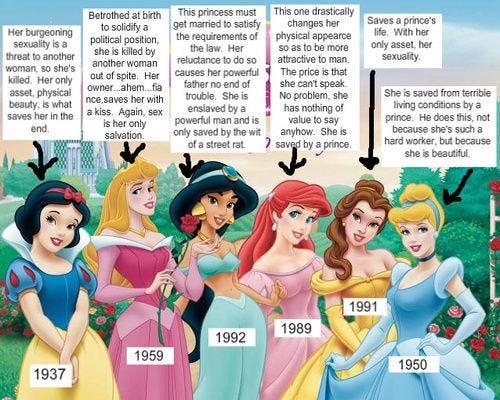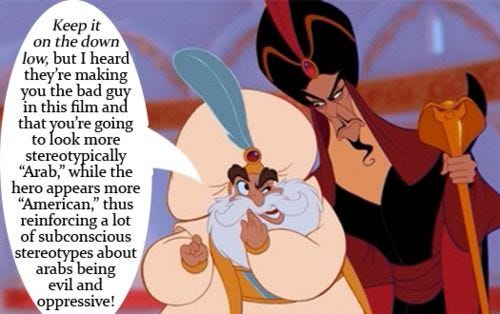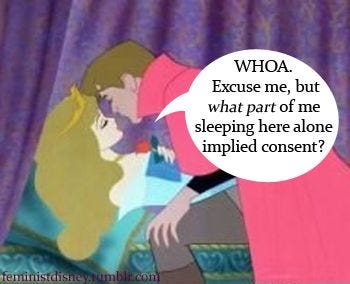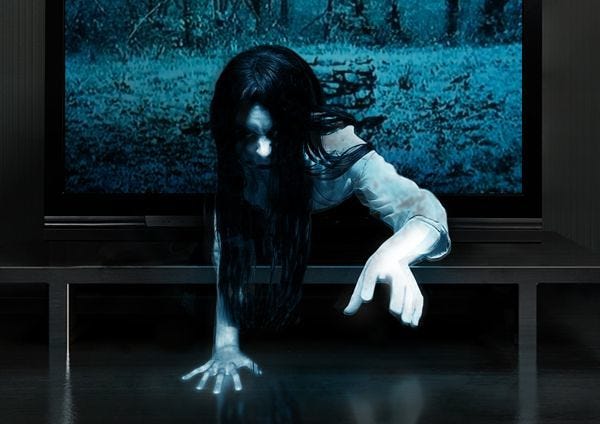Running to Red will always be a free publication, but if you’d like to support me and my work, please consider a paid subscription. 🍒
The Message
Like most women who grew up in the 90s, I was raised on Disney. And specifically, the Disney princesses. For context, I was born in 97 (ok, late 90s kid?), meaning the Disney princess lineup was as follows:
Snow White
Cinderella
Sleeping Beauty
Arielle
Bell
Jasmine
Pocahontas
Mulan (released in ‘98)
The next princess movie wasn’t released until ‘09 with Tiana and The Princess and The Frog. Aside from the obvious lack of racial diversity, all of these princesses have one thing in common: a male counterpart. A prince. A (colonialist, white) savior. Disney says a princess was always kind. She was beautiful and skinny and pasty as glue. And she was deserving of love for these reasons; the love always being heterosexual. The misogyny seeps out of the screen like Samara1. The message, repeated over and over on grainy VHS, was clear: loving a man won’t just save you, it is the ultimate goal to strive for.
At least, this was the message for young, white girls. I would be remiss if I did not include how Disney also worked (and works still) to ignore, profit off of, and/or purposefully spread stereotypes about marginalized groups. Their first non-white princess, Pocahontas, still ends up falling in love with a white man, and a colonizer no less. Look kids, the native Americans and colonizers loved each other! Native genocide and diseases brought from Europe are meaningless to Disney. This is one way the company works to uphold white supremacist ideals of girlhood and to exclude marginalized groups. Even now, Disney has announced they will be “moving away from” DEI and have cut a trans storyline from one of their shows in favor of adding a Christian character instead23. The Disney company has always held these views — now they're just being transparent about it.
Boy Crazy
I can remember from early on always going after boys. I always wanted to be around them. Play with them at recess, share my snacks, anything to get recognition. I remember blowing off female friendship for the chase (literally around the playground) of a boy to hold. My girlhood felt, and still feels, stunted by my singular goal of developing relations with the opposite sex.
By middle school, another friend and I would write fanfiction in class about the boys in our grade. We would pass my composition book back and forth, writing the next line or scene. I remember vividly writing about myself and a boy from our math class having sex on a plane as we flew to our next spy mission. We were 11.
At 12 I had my first boyfriend. We sat next to each other in class and did the musical together. We were friendly, but on reflection, I coerced this poor boy into dating me. It lasted about a week — rightfully so — but I was hooked on the attention and exclusivity of “dating.” At 13, while still in middle school, I began dating a high school freshman and quickly found myself sending nudes and performing sexual acts in order to keep it going. Men don’t like prudes! Be a good girl. Be a princess and hold still.
I have never been single, or without a FWB, since. Yes, since I was 12. I moved from one relationship or hookup to the next, like a bee to a flower. Dating apps were my main form of entertainment. Centering my worth around the patriarchal gaze led to years of psychological damage and disordered eating. I repressed my attraction to women, my own values, old hobbies and friends. It feels like I am only now taking down the dusty box that holds my true self — the one long forgotten since the first hints of puberty.
Insidious Intentions
Disney perpetrates this brainwashing on purpose. It is no secret that these films are a product of their time, but the messaging transcends that context. Sleeping Beauty was released in 1959 and focuses on Aurora. Blonde, white, skinny, and naive. She cooks and cleans in her little cottage like the most humble and dedicated homemaker. She has no real ambitions and no discernable personality aside from “pretty and nice.” And that is all that is needed for the prince to fall in love with her; no bar trivia stats required. She meets her prince in the woods of all places, and they are instantly smitten without sharing a single thing about themselves. She has little to no agency throughout the entire film; things are done to her or for her. And, sure, he doesn’t rape her while unconscious in this version, but she is still kissed without giving consent. What a great message for little girls! And then they get married and live happily ever after (even though the prince will soon become king and likely keep Aurora in her good submissive role). It’s a beautiful and easy formula for any budding tradwife to follow.
Subtext dictating how a woman should act to be desirable is not going to be evident to a child. They can’t yet think critically about the media they consume. And Disney in undeniably children’s entertainment; the writers and animators were very intentional in the stories they were telling. Starting this messaging young serves to keep girls in their place. They need to center their aspirations around their marital pursuits. And this messaging provides long-term indoctrination into the WASP-wife ideal. More heterosexual couples mean more kids, more Disney sales, and more workers to help keep the Disney monopoly up and running.
Yes, Disney has released more “feminist” princesses — Merida for example — but at the behest of women and parents who have grown up to realize that the existing messaging in these films is one of submission, not action. Not sure if I need to say this but I am actively boycotting Disney. And I hope others do too since it seems they are only doubling down on protecting their misogynistic, white supremacist foundation.










this is fantastic
Incredible read! I read that Kira Knightley doesnt let her daughters watch those movies for the same reasons!